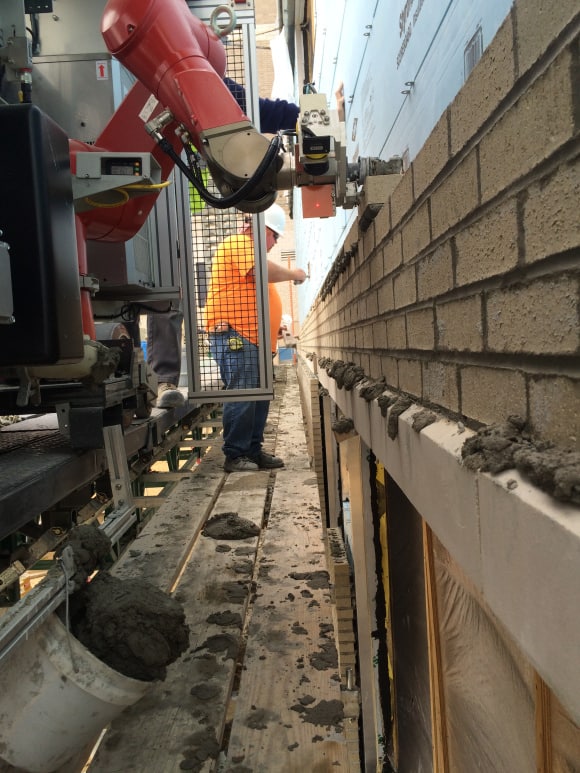Winchester, Va. — SAM is the construction worker who never takes a break. SAM never gets sick. SAM can lay approximately 100,000 bricks in a single month. Just don’t ask SAM to do corners.
Earlier this year, SAM—or a “semi-automated mason”—showed up at the construction site of Shenandoah University’s new 80,000-square-foot James R. Wilkins Jr. Athletics & Events Center in Winchester, Va.
“It was interesting,” said Donnie Werdebaugh, a 40-year construction vet of the Virginia-based general contractor Howard Shockey & Sons, who, at first, was dumbfounded when the foreman of his project started telling him about the bricklaying robot which looks like a giant refrigerator with a robotic arm and a conveyor belt.
Werdebaugh watched the whole process of brick work change before his eyes as the robot placed nearly 375,000 bricks during the next three months—a job that would have taken one construction worker more than 20 months to do.
“I’ve been on projects [prior] where we didn’t have a robot, and we had a lot of bricks to lay and needed 20 masons, but we only had 15,” Werdebaugh recounted to Commercial Observer. The robot “enhanced manpower, and it enhanced production.”
Over the past decade, new companies have been popping up with robotics to handle a myriad of tasks on construction sites from bricklaying to surveying to welding. While various construction management executives and experts with whom CO spoke agreed that the robotics industry is still very nascent in the construction business, the demand is there, and startups are testing more devices all the time.
Construction Robotics, a 20-person startup based in Victor, N.Y., started working on SAM in 2007. After about eight years of development, research, polling and tweaking, it began selling the bot two years ago.
It’s easy to see why SAM is desirable. The machine can lay just over 3,000 bricks a day, more than five times faster than an average human, who can lay between 500 and 600 bricks daily—and it lays bricks perfectly vertical. SAM was so fast on the Shenandoah University job site, it set a world record for the most bricks laid in an eight-hour period at 3,270, according to Construction Robotics’ website. Shenandoah University tweeted about the work and “will continue to partner with [general contractors] to utilize industry trends,” according to Jeff Davis, the university’s physical plant project manager.
Of course, SAM is not yet taking over the construction industry. For starters, there are only 10 of them (five of which have been sold, and the remainder are for rent at an undisclosed amount), according to Rafael Astacio, the director of sales for Construction Robotics. Plus, SAM costs $425,000 (down from the original price of $500,000 two years ago). Also, SAM can’t really work on corners well, Werdebaugh said. A long horizontal surface without protruding items is perfect for it to handle. Coming in at 3,000 pounds, SAM requires a reinforced scaffold to move up and down walls.
Now Construction Robotics is working on its second product, a mini-crane-like arm that would allow a contractor to move heavy blocks of concrete at construction sites. The bot, which should be available for sale by the end of the year, will retail for $65,000 to $70,000.
The demand “is coming because the older generation is moving on and the younger generation is more [accepting of that] that kind of change,” Werdebaugh said. “It is something that took this younger generation.”
One point of pride for the company is that it doesn’t eliminate the need for humans, Astacio said. “The mission of our company is not to replace humans. The main mission is to keep developing this collaborative robot to work alongside the mason and take out the heavy lifting.”
SAM has a conveyor belt of bricks and a robotic arm that grabs the bricks, lathers them with mortar and places them on the wall. Workers are needed to survey the machine and make sure it is working correctly, feed it more bricks and trail the robot’s work to smooth over the concrete.
###
Source: Construction Observer, by Liam La Guerre. Read the full article here.

